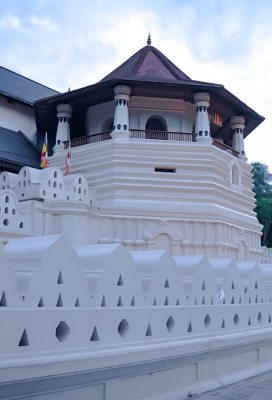Dalada Maligawa
a Land like no other
a Land like no other

Nestled in the heart of Sri Lanka’s hill capital, Kandy, Dalada Maligawa, also known as the Temple of the Sacred Tooth Relic, is one of the most significant religious and cultural monuments in the country. Revered by Buddhists all over the world, the temple houses Sri Lanka’s most sacred relic—the left canine tooth of Gautama Buddha. The stunning architecture, religious significance, and historical importance make Dalada Maligawa a must-visit site for any traveler exploring Kandy.
Located in Kandy, Dalada Maligawa is easily accessible from the city center. The temple is situated within the Royal Palace complex, just 1.5 kilometers (less than a mile) from the Kandy Railway Station and the main bus terminal, making it highly convenient for visitors staying in the city.
From Colombo, the bustling capital of Sri Lanka, the temple is approximately 116 kilometers (72 miles) away. The journey takes around 3 to 4 hours by car or public transport. Here's how you can reach Dalada Maligawa from Colombo:
Dalada Maligawa is not just a tourist attraction, it’s a spiritual epicenter for Buddhists worldwide. The Temple of the Tooth is considered the holiest Buddhist site in Sri Lanka because it houses a relic of the Buddha himself. According to legend, after Buddha’s cremation in 543 BCE, his left canine tooth was retrieved and has since been safeguarded by various kingdoms before finding its permanent home in Kandy.
For centuries, possession of the relic symbolized the right to rule the island, and it has been an object of veneration for pilgrims from across the Buddhist world. The temple plays a central role during Sri Lanka’s grandest religious celebration, the Esala Perahera, a procession that attracts thousands of devotees and tourists annually.
A visit to Dalada Maligawa is a multi-sensory spiritual journey that immerses you in centuries of Buddhist rituals, history, and culture. As soon as you step onto the sacred grounds, the air is filled with the scent of burning incense, the sound of monks chanting, and the vibrant colors of offerings left by devotees.
At the heart of the temple is the shrine room that houses the sacred Tooth Relic. While visitors cannot directly view the relic itself—encased in a golden stupa within a secure inner sanctum—daily rituals known as Thevava are performed by the monks, during which devotees can offer flowers and light oil lamps. It’s a humbling and spiritual experience to witness these rituals, as the temple is often filled with locals paying their respects.
The Magul Maduwa, or Audience Hall, is a stunning example of Kandyan architecture, with its carved wooden pillars and open layout. This hall was historically used by the kings of Kandy for important ceremonial events. Today, it stands as a reminder of the grandeur of Kandy’s royal history, and visitors can admire its exquisite craftsmanship.
Within the temple complex is the Museum of Sacred Relics, a treasure trove of artifacts related to Buddhism, the temple’s history, and the Kandy Kingdom. You can explore various exhibits displaying ancient manuscripts, offerings from various countries, and historical artifacts connected to the veneration of the Tooth Relic. It’s a fascinating way to dive deeper into the cultural and religious significance of the temple.
Music is an integral part of Buddhist rituals at Dalada Maligawa. Near the entrance to the shrine room is the Pavilion of Drummers, where drummers and musicians perform traditional Sri Lankan percussion music during the morning and evening rituals. This unique experience adds to the spiritual ambiance, with rhythmic drumbeats echoing throughout the temple complex.
On the temple grounds, you’ll also find a sacred Bodhi tree—a direct descendant of the original tree in India under which Buddha attained enlightenment. Devotees offer prayers and offerings here as part of their pilgrimage to Dalada Maligawa.
Just outside Dalada Maligawa is the Royal Palace of Kandy, which has been partially converted into museums and galleries. Visitors can explore the palace grounds, where Kandy’s kings once ruled, and gain insight into the rich history of the Kandy Kingdom. Additionally, the nearby Kandy Lake offers a tranquil escape after a temple visit, perfect for a relaxing stroll.
Many visitors combine their visit to Dalada Maligawa with other key sites in Kandy and the surrounding areas. Here are a few popular itineraries:
Dalada Maligawa is situated in the city of Kandy, which lies at an elevation of approximately 500 meters (1,640 feet) above sea level in Sri Lanka’s central highlands. The city is surrounded by rolling hills, lush vegetation, and tea plantations, contributing to its cool and pleasant climate year-round.
The region’s geography is defined by its tropical highland climate, characterized by mild temperatures compared to the coastal regions. The nearby Mahaweli River, the longest river in Sri Lanka, flows through the area, adding to the scenic beauty of Kandy and its surroundings.
While Dalada Maligawa is open year-round, the best time to visit is during Sri Lanka’s dry season, from December to April. The weather during this period is cooler and more pleasant, making it ideal for exploring the temple and other nearby attractions. Additionally, if you’re interested in experiencing the Esala Perahera, visit during July or August when this grand procession takes place, attracting thousands of visitors and devotees.
2024 kandycity.org, All rights reserved | Home | Terms and Conditions | Privacy Policy | Disclaimer | Twitter | Instagram | Kandy City Guide | Contact us